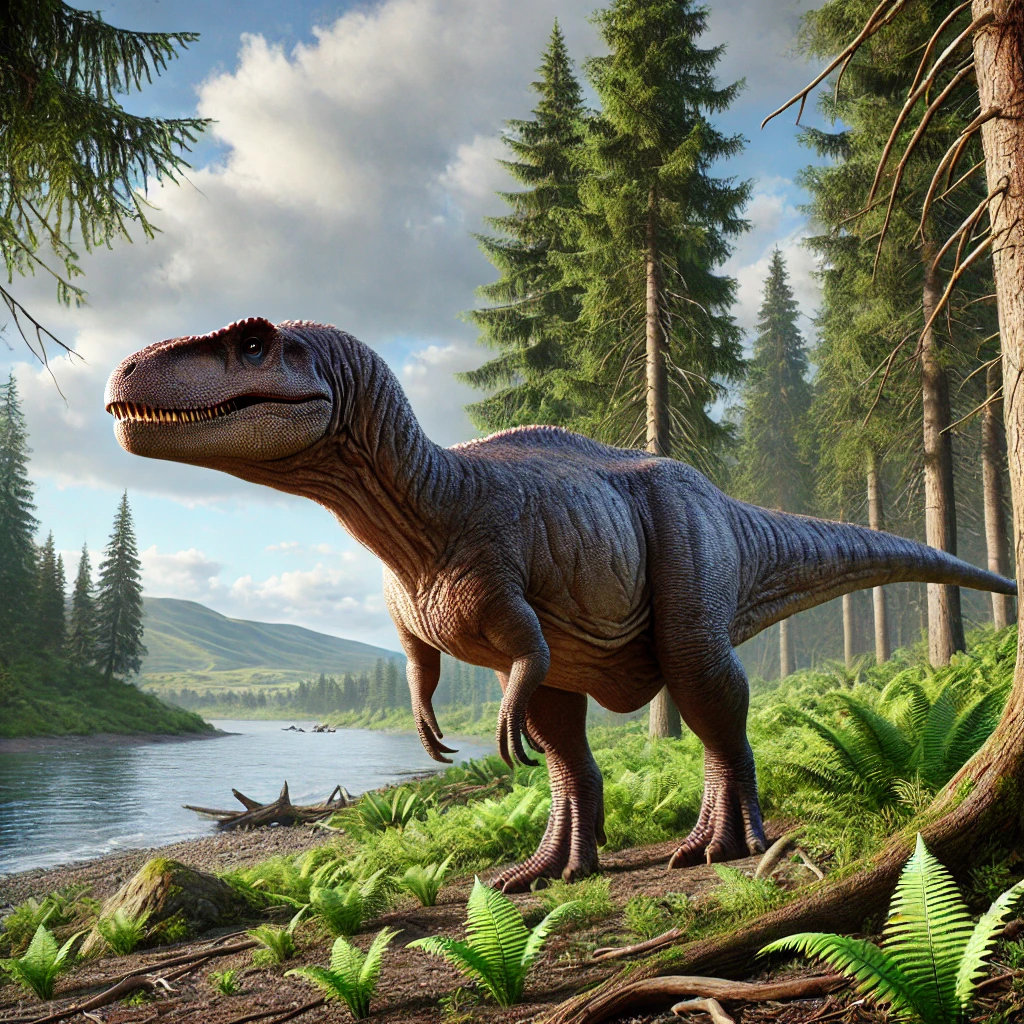Albertosaurus
Pronunciation:
Al-ber-toh-sore-us
Name Meaning:
“Alberta lizard,” named after the Canadian province of Alberta where its fossils were first discovered.
Dinosaur Classification:
- Kingdom: Animalia
- Phylum: Chordata
- Class: Reptilia
- Order: Saurischia
- Suborder: Theropoda
- Family: Tyrannosauridae
- Genus: Albertosaurus
- Species: A. sarcophagus
Dinosaur Description:
Albertosaurus was a bipedal, carnivorous dinosaur that lived approximately 70 to 66 million years ago during the Late Cretaceous period. A close relative of the more famous Tyrannosaurus rex, Albertosaurus was smaller but still a formidable predator. It measured about 30 feet (9 meters) in length and stood around 10 feet (3 meters) tall at the hips. Its skull was about 3.3 feet (1 meter) long, and it had sharp, serrated teeth designed for slicing through flesh.
Despite being smaller than T. rex, Albertosaurus had many similar features. Its short, powerful arms each had two fingers, and its massive jaws were filled with sharp teeth that could crush bone. Its powerful hind legs suggest it was a fast runner, which would have made it an effective predator of smaller herbivorous dinosaurs such as Hadrosaurids.
The skull of Albertosaurus had a number of openings, reducing its weight and providing places for muscle attachment, giving it a strong bite. Like many theropods, it had forward-facing eyes, providing good depth perception for hunting. Its tail was long and heavy, helping to balance its large head and body.
Albertosaurus likely hunted in packs, as suggested by fossil evidence of multiple individuals found together at some fossil sites. This pack behavior would have allowed it to take down larger prey or protect territory from other predators. However, Albertosaurus might also have been a solitary hunter, depending on the prey and environment.
Though smaller than the T. rex, Albertosaurus played a key role as a top predator in its ecosystem, dominating the food chain in what is now North America during the late Cretaceous.
Dinosaur Diet and Behavior:
Albertosaurus was a carnivore and likely preyed on large herbivorous dinosaurs such as Hadrosaurs and possibly young Ceratopsians. Its sharp, serrated teeth were ideal for slicing through flesh, and its powerful legs allowed it to chase down prey. Evidence suggests that it may have hunted in packs, which would have allowed it to take down much larger animals.
Dinosaur Size:
Albertosaurus measured around 30 feet (9 meters) in length and stood approximately 10 feet (3 meters) tall at the hips.
Dinosaur Weight:
Albertosaurus weighed between 1.5 to 2.5 tons (3,000 to 5,500 pounds), making it a relatively lightweight member of the Tyrannosauridae family, which likely contributed to its agility and speed.
Fossil Discoveries:
The first Albertosaurus fossils were discovered in 1884 in the Horseshoe Canyon Formation in Alberta, Canada, by geologist Joseph Burr Tyrrell. Since then, many more specimens have been found across North America, including in Montana and Wyoming. One of the most significant discoveries was a mass grave of at least 22 individuals, suggesting the possibility of pack behavior. These finds have been invaluable in helping paleontologists understand more about the anatomy, behavior, and ecology of this Late Cretaceous predator.
What Period Did The Dinosaur Live:
Albertosaurus lived during the Late Cretaceous period, approximately 70 to 66 million years ago.
Notable Facts or Trivia:
– Albertosaurus is named after the Canadian province of Alberta, where its fossils were first discovered.
– Despite being smaller than Tyrannosaurus rex, Albertosaurus was a formidable predator and is believed to have been faster.
– Evidence suggests that Albertosaurus may have hunted in packs, a behavior not commonly associated with many large theropods.
– Albertosaurus is one of the best-understood members of the Tyrannosauridae family thanks to the numerous fossil discoveries.
Scientific Significance:
Albertosaurus is significant for its contribution to our understanding of the evolutionary history of tyrannosaurids. Its fossils, especially the mass grave discovery, have provided strong evidence for the social behavior of theropods. Albertosaurus also serves as an important reference point for studying the biogeography of dinosaurs in North America during the Late Cretaceous period, illustrating the distribution and variation of large carnivorous dinosaurs across the continent.
Extinction & Legacy:
Albertosaurus, like most dinosaurs, became extinct around 66 million years ago at the end of the Cretaceous period, during the mass extinction event likely caused by an asteroid impact. However, its legacy lives on through the many fossils found, which have contributed to our understanding of theropod biology, behavior, and the ecosystems of the Late Cretaceous. Albertosaurus is a well-studied dinosaur, with its remains displayed in museums across the world, captivating the imaginations of paleontologists and dinosaur enthusiasts alike.
